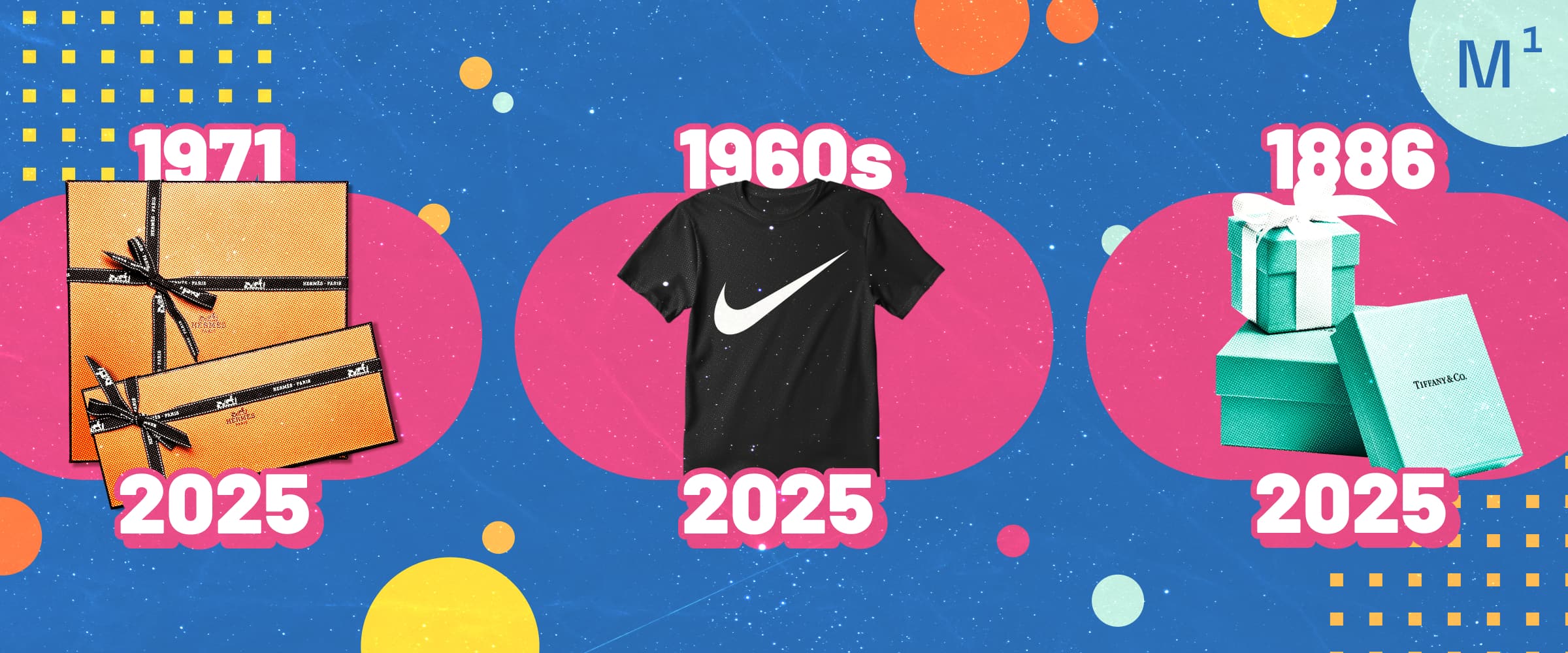
The Insanely Persuasive Power of Brand Consistency
I recently took my daughter to her pediatrician for a regular checkup. And as we worked our way down the long list of questions concerning her development, my brain kept clocking the word "exposure." Exposure to new people. Exposure to language. Exposure to dreaded green vegetables.
That's when it hit me (as these things tend to, when you're a marketer obsessed with behavioral science): the pediatrician was describing the " mere exposure effect" in action. It’s the proven behavioral principle that confirms the more we see something, the more we trust and like it.
I’d never considered how wonderfully effective consistency could be at getting toddlers to eventually accept broccoli! Just as effective, it turns out, as it is at building indulgence brands.
It’s the secret many marketers won’t readily admit: you don't need to reinvent your marketing year-to-year for your brand to be successful. When you have simple, clear strategies grounded in your brand's strengths and a compelling campaign that brings that strategy to life, consistency deserves its chance to deliver—because it will.
Don’t take my word for it. Effie + System1's recent report draws a clear line between consistency and ROI, with the most consistent campaigns having a 2.9X profit multiplier.
So why aren’t more brands keeping consistent? At face value, it might seem simple. But consistency can actually be remarkably difficult to maintain—especially as businesses expand, brand goals shift and team members come and go.
But I'll be honest. The biggest obstacle to consistency isn't always organizational change. Sometimes ... it’s us.
Why Marketers Can't Help Themselves
We’ve all been in those meetings. You know the ones—where someone says, "We need to shake things up." Or, "Let's try something completely different." The room gets excited. The energy shifts. And before you know it, the team is madly reimagining why the brand matters.
Marketers are addicted to novelty. We love new ideas, and we are obsessed with the latest technology. The problem? Our inclinations have nothing to do with consumers. We simply get tired of our work much sooner than they do.
I've actually spent the bulk of my career being the person at the table arguing against shiny new campaign concepts. I've evangelized for brand consistency—fiercely, at times—even when it unsettled CMOs eager for fresh creative to address this year’s brand challenges.
Of course, marketing’s bias toward the new and shiny makes sense. We can spend months or even years on a campaign before it ever sees the light of day, and by that time, we’re over it.
But here's the thing that keeps me up at night (besides my toddler): If you've built any kind of brand equity, replacing your most recognizable brand assets or campaigns—even if you do have new features or flavors to promote—is incredibly risky.
Why? Because whether you’re a fine whiskey or a premium treat, consistency makes choosing your indulgence brand easier.
And that’s the difference between being picked up or overlooked the next time your consumer is in buying mode.
How Consistency Works
Behavioral science explains why consistency is so good at reinforcing awareness and driving repeat purchase.
As psychologists Susan Fiske and Shelly Taylor determined long ago, we human beings are “cognitive misers.” Our brains prefer emotional triggers and mental shortcuts that make our choices feel effortless, enabling us to conserve our precious cognitive energy.
New is fun. New gets attention. There’s a job for new—first impressions are incredibly influential. But when we ask consumers who already know a brand to get to know it again, we’re requiring them to put in extra mental effort their brains would rather skip.
Most consumers, fielding 10,000 brand messages a day, are already cognitively taxed. That means consistency is a secret weapon for making choice feel easy and automatic—or as Method1 likes to call it, “irresistible.”
Irresistibility is particularly critical for indulgence brands to develop. Unlike functional products, our consumers must grant themselves permission to indulge, adding an extra layer of deliberation that can spell the difference between making a purchase or passing the brand by.
Let's walk through how consistency creates that irresistibility, examining just three behavioral principles at work.
1. Consistency Breeds Familiarity
Let’s get back to my pediatrician visit and the power of repeated exposure.
Psychologist Robert Zajonc first put the mere exposure effect on the map in the 1960s, when his research revealed that exposure alone is enough to build preference and drive appeal.
This principle comes first because it explains why brands advertise at all. It's also why effective media plans strive for a consistent drumbeat of brand exposure throughout the year. And why changing those elements constantly undermines everything.
When brands constantly reinvent their look, messaging or even their shelf placement, they reset the exposure clock to zero.
Consider how this plays out in real shopping moments.
A consumer standing in the spirits aisle, overwhelmed by choices, naturally gravitates toward what feels familiar. Not what's newest or loudest, but the brand they've reached for before, the one that's always been there. That feeling of comfort— I trust this one—often determines which brand goes home with them.
So every opportunity to remind people your brand exists is an opportunity to make choosing it feel irresistible the next time they're shopping. Consistently showing up in the places and spaces where your consumer expects to find you—just that act alone—gives you a leg up.
No clever tagline required. No revolutionary campaign needed. Just the powerful pull of familiarity working in your favor, building trust through every repeated encounter.
2. Consistency Enhances Memorability
It’s the simple question I include on every single brief: How will people know it's your brand?
It sounds basic, but considering a recent report found 2 in 10 viewers globally have no idea what brand an ad is for, this question can't be overlooked.
In behavioral science, the "Von Restorff effect" tells us that the more something stands out from the crowd, the more likely it is to be seen and remembered. When it comes to brand marketing, this often translates to what the Ehrenberg Bass Institute calls distinctive brand assets.
A distinctive brand asset is a unique written, verbal or other sensory element that has few associations with your competition and therefore comes to represent your brand.
Examples include:
- Logos
- Brand characters (like the Geico Gecko or Alfie the seal from Method1 client Cape Tide Hard Tea)
- Jingles
- Sonic devices
- Unique color combinations that eventually become indistinguishable from the brand
Just think Tiffany's blue boxes or the iconic Nike swoosh.
Or take Method1's work with Lunazul. Instead of trying to out-shout celebrity tequilas, we leveraged the moon, already embedded in the brand name, as a distinctive asset that made the brand unmistakable across touchpoints. We combined this iconography with a "Look to Luna" campaign, reinforcing strong visual cues that make remembering the brand effortless–driving a 95% increase in search volume.
All that said, building distinctiveness is only one part of the equation.
When marketers build distinctive assets through ruthless consistency and repetition, they create powerful brand codes: the unique visual, verbal or sensory cues that make the brand unforgettable—triggering instant brand recognition wherever they appear.
When you consistently embed your distinctive brand assets in consumers' memories, you increase the likelihood of popping into their heads when they're reaching for that pint of ice cream or scanning the back bar when asked, "What can I get you?"
And once you have distinctive assets working hard at making you memorable? Change them at your peril.
Look no further than Tropicana's infamous package redesign. Lack of consistency led to this category leader being overlooked at shelf, or even worse, being mistaken for generic juice.
3. Consistency Supports Habit Formation
When it comes to consistency, we're just a hop, skip and a jump from conversations around habit formation. And while there may be debate on exactly how long habit formation takes (21 days? 66 days?), there's consensus that it takes a combination of intent, time and consistency.
The same tenets apply to building brand loyalty. Irresistible brands end up becoming habits for consumers, products that people just continue to pick up without a second thought.
The good news? We're wired for habit formation because—yet again—it minimizes the cognitive effort needed to make it through the day. Thanks to the “status quo bias,” we’d much rather stick with what we’re already doing than switch to something new.
As marketers, this means we need to:
- Create the right conditions for a brand or product to become the status quo
- Show up in a consistently distinctive way so we’re easy to see and find
- Maintain our presence and consistency at all costs
Think about Coca-Cola. It consistently shows up across media, event venues, movie theaters, restaurants and virtually any other place you might want to grab a soda. And while the brand’s campaigns have changed over the decades, their distinctive red and white font is unmistakable.
The ease with which this brand comes to mind and can be found makes it irresistible—so much so that Coca-Cola Classic is still the best-selling soda brand today.
Or consider Method1's work with Old Fitzgerald Bottled-in-Bond 7-Year-Old. The brand is positioned as the bourbon of hospitality—the one you bring to dinner parties or the one you pour for guests. By consistently reinforcing this role, Old Fitzgerald becomes the irresistible, go-to choice when only a thoughtful bourbon will do.
Master Consistency, Unleash Creativity
After years of being the consistency advocate (sometimes the only one in the room), I've realized something: consistency isn't just about marketing efficiency or ROI—though that 2.9X profit multiplier is nice.
It's about respect.
Respect for the cognitive load our consumers carry. Respect for the brand equity we've worked so hard to build. And respect for the long game in a world obsessed with quick wins.
When I pick up household essentials now—between managing two kids and a career—I have a new appreciation for the brands that make themselves easy to find and choose. The ones that don't make me think. The ones that have been there, looking the same, delivering the same quality, in the same spot on the shelf.
These brands have earned something powerful: the freedom to surprise me precisely because they've been so dependable.
Consistency turns your brand into a trusted friend in a world of strangers. And when you're trusted? That's when you can take creative risks.
McDonald's can break apart their golden arches to point to the nearest drive-through or highlight a Canadian delivery offering with eye-catching OOH because its distinctive brand assets are so deeply encoded in our minds. Heinz can run a “Draw Ketchup” campaign where consumers sketch from memory because their bottle shape is unforgettable after decades of consistency.
So the next time someone in your meeting suggests "shaking things up" or "trying something completely different," ask:
Have we given our brand enough exposure to work? Have we been consistent enough for long enough to earn the right to play?
Because just like my daughter will eventually accept those green vegetables (fingers crossed), your consumer can eventually find your brand irresistible—but only if you give consistency the time and commitment it deserves.
To see behavioral principles in action making indulgence brands irresistible, explore Method1’s work.
About the Author
Allison Arling-Giorgi, Head of Brand at Method1, is an expert brand-builder who harnesses deep understanding of human behavior to drive real business impact. She has spent her career helping brands in CPG and spirits industries make sense of consumers and culture, translating insight into highly effective and awarded work. Allison has been a featured speaker at conferences across the U.S., and has also contributed to the PBS Frontline documentary “Generation Like,” the UK Daily Mail and MediaPost.
Ready to
make your brand
irresistible?
